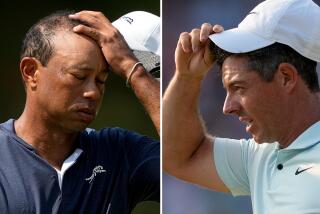BRITISH OPEN : Winning Ugly Is Par for Course : Golf: No one really likes Royal St. George’s, but someone will have to come out on top.
- Share via
SANDWICH, England — There is debate here about whether Royal St. George’s is a golf course or an abandoned mine field, discussion as to whether the 1993 British Open should be considered good golf or good grief.
The quest for golf’s most revered championship begins today on storied--some would say unmanageable--grounds.
The course at Royal St. George’s is the Candlestick Park of the Open rotation, an expanse of pasture rigged with bad hops, swirling winds and flying fish-and-chips wrappers.
When Jack Nicklaus shoots 83 here, as he did in 1981, it is probably time to take stock of the place.
This is the 12th Open to be played at the 106-year-old course, and consider that only one winner, Bill Rogers in 1981, has broken par for the tournament.
The last time the Open was held here, 1985, Sandy Lyle won and some top Americans didn’t bother to show, including Curtis Strange, the tour’s leading money winner at the time; and Andy North, the reigning U.S. Open champion.
The Americans have returned this year, in part because of the new rule that exempts the top 50 ranked players from qualifying.
But they come to Royal St. George’s begrudgingly, hoping to slay the bunkers.
Irish player David Feherty once described it this way: “It’s the toughest, but at no stretch of the imagination could you call it a golf course.”
Upon first laying eyes on Royal St. George’s, an American would be inclined to ask, “What year will it be finished?”
It was finished in 1887.
If the course was relocated to Southern California, it is unlikely anyone would play it. You might giggle past it on your way to a public course.
At Royal St. George’s, there are no trees and no water. No hope, some would suggest. The fairways remind of a rolling, lunar landscape, punctuated by 40 bunkers on the front nine, 60 on the back.
Some traps appear to have been carved out by mortar, not shovel.
The eighth hole offers a bunker called “Hades.” It was described a century ago as “downhanging, terrible and vast,” and nothing about it has changed.
The monster bunker of them all is an obstacle that rises at a 60-degree angle from the fourth fairway.
A bunker any deeper would require a rescue by airlift.
Tom Watson is a five-time British Open winner but said he is a relative duffer at Royal St. George’s.
“If I can beat Nicklaus, I’ll be all right,” Watson joked.
On his first round trip here in 1977, Watson shot a 78. He finished 23rd in the 1981 Open and 47th on this course in 1985.
“It’s bumpy, very bumpy, huge bumps, hilly,” Watson said. “That’s the flavor of the course. In America, if you built a course like this, they would say, ‘What is this guy drinking?’ ”
For all its shortcomings, Royal St. George’s remains one of England’s snootiest establishments, a club at which rules are to be adhered to, suits and ties are to be worn and women are not to be seen.
Ian Fleming, author of the James Bond series, was a member here and used St. George’s as a model for the course he described in his novel, “Goldfinger.”
Fleming referred to the course in his book as “St. Marks.”
They have reworked some of the blind shots on the course, but this is small consolation. Stateside players accustomed to smooth fairways and soft greens--target golf--are in for quite a shock.
“I know one thing,” said Greg Norman, the 1986 British Open champion at Turnberry. “I’m going to be taking my good-luck pill when I wake up each morning.”
The course does not serve youth well.
Lee Janzen, the reigning U.S. Open champion, is not given much of a chance here, this being only his second British Open and his first trip to Royal St. George’s.
“I don’t know how well Lee Janzen will cope,” Faldo said. “It will be pretty alien to him.”
It is easier to project a survivor than a winner.
The two Nicks, Price and Faldo, are obvious favorites, possessing the talent, heritage, experience and patience to negotiate the links course.
Faldo says you have to drive the ball low to stay alive. High-ball hitters, such as John Daly, are more apt to recover their drives in Sandwich Bay.
“If the wind blows real hard, there’s no telling what I’ll do,” Daly conceded.
Watson likes Paul Azinger’s chances.
English oddsmakers are closing fast on Payne Stewart, even though he has not won since his 1991 U.S. Open triumph.
But Stewart has been stellar of late.
Last month, Azinger robbed him of victory at the Memorial Tournament. Two weeks later, Stewart lost another heartbreaker to Janzen at the U.S. Open at Baltusrol.
Stewart also plays Royal St. George’s well, having finished second to Lyle in 1985.
“I’m playing right at the top of my game,” Stewart said, “and depending on the bounces you get out here and with patience, I don’t see why I can’t win.”
Here, your best drive is liable to kick off a mound and into the high brush. Here, on the next hole, a bad tee shot might catch a inward slope and leave you in perfect position.
With a paucity of rain, the greens are coffee-table hard. They are not, unfortunately, coffee-table flat.
And the wind wouldn’t be so bad if it blew the same direction for any given stretch of time.
It doesn’t, but such is the nature of the seaside beast.
“I think British golf is real golf,” Norman said. “I think the ball is round, it’s designed to roll, it spins different ways, so you can make it spin, this type of golf is true golf.”
Lyle is one of the few who feels at home at Royal St. George’s.
“I enjoy the course,” he said. “I hear other reports that it’s too tough, it bounces here and there, but I like it.”
Let the winner beware: The last two champions are still searching for their games.
After his 1981 victory, Rogers started a free fall down the money chart that ultimately landed him as director of golf at the San Antonio Country Club.
Lyle, too, has known mostly misery since.
Is this the price to pay for winning at Royal St. George’s?
No one said it should be easy. Most assumed, though, that it would be golf.
Still . . . .
“This is the true world championship of golf,” Watson said. “It has the fairest conditions of entry of any Open.”
True enough. Royal St. George’s is unfair to everyone.
Facts and Figures
* Site: Royal St. George’s, Sandwich, England. * Yardage: 6,860. * Par: 35-35--70. * Format: 72 holes, stroke play. * Cut: After 36 holes, the field will be reduced to the low 70 and ties. * Playoff (if necessary): In the event of a tie for first after 72 holes, playoff will be over four holes, stroke play; if two or more remain tied, playoff continues under sudden-death format. * Field: 156, (150 pros, 6 amateurs). * Purse: $1.5 million. * Winners share: $150,000. * Defending champion: Nick Faldo. * Last winner at Sandwich: Sandy Lyle (1985). * Former champions in field: Faldo, Ian Baker-Finch, Seve Ballesteros, Mark Calcavecchia, Lyle, Jack Nicklaus, Greg Norman, Tom Watson. * TV: Today and Friday, 6 a.m.-11 a.m., ESPN; Saturday, 7 a.m.-11 a.m., Channel 7; Sunday, 6:30 a.m.-10:30 a.m., Channel 7.
More to Read
Go beyond the scoreboard
Get the latest on L.A.'s teams in the daily Sports Report newsletter.
You may occasionally receive promotional content from the Los Angeles Times.











